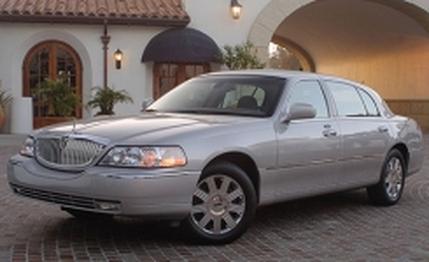 Short Take Road Test
Short Take Road Test
Of all the synopses we might employ to quantify the 2003 Lincoln Town Car, we confess that "addictive driving experience" never occurred to us. More composed, yes. More refined, yes. Better-looking, still yes. But addictive? Please.
Nonetheless, "addictive driving experience" is the three-word mission statement describing the engineering goal Lincoln has set in its latest attempt at self-reinvention. It's laudable, for sure, and applied to some current Lincolns — the LS sedan comes to mind — it even approaches reality. But from our perspective, the updated Town Car is no more addictive than tofu or hospital Jell-O.

That said, there is clear improvement here, going right down into the bones. The forward frame rails are hydroformed steel, the No. 2 crossmember — supporting the engine mounts and front suspension — is hefty cast aluminum, and crossmember No. 3 — a little aft of the front wheel wells — has been strengthened. According to the engineering team, these measures add up to a 24-percent improvement in torsional rigidity, particularly noteworthy in a body-on-frame automobile. (It's easier to enhance rigidity when the body shell and the frame rails are integrated, as is common with almost all passenger cars today.)
The new front framework supports a redesigned front suspension — short and long control arms, with coil springs, monotube shocks, and an anti-roll bar — plus, more important, a new variable-assist power rack-and-pinion steering system, replacing the old recirculating-ball setup.
There's another significant change at the rear of the car. It's still a live axle, located by a Watt's linkage, but just above those ultra-traditional mechanicals the designers did a good thing. They moved the spare tire from its former awkward perch, squarely in the middle of the trunk, into the right fender well. This increases trunk capacity only slightly — 21.1 cubic feet versus 20.6 for the previous model — but opens up the middle, and that, plus a 7.8-inch increase in the width of the decklid opening and a fractional reduction in lift-over height, make the cargo hold much easier to get at.
Although front-seat travel has been increased by 1.5 inches, interior volumes are unchanged, since roominess has long been a selling point of this largest of American passenger cars. Accordingly, the interior-design team was able to devote its development budget to cosmetic updates, including a new instrument panel that looks simultaneously more elegant and more contemporary. As you'd expect, all Town Cars come with a comprehensive list of standard luxury features, and if the seats are utterly devoid of lateral support, they're at least power adjustable, leather clad, and living-room comfy. Considering the car's mission, though, we're mystified by a couple of omissions: There is no one-touch-up feature for the power windows, and no driver's dead pedal. Check the competition, guys.
The exterior has also received several tweaks, a much bigger grille being the most readily apparent of them.
Although the Town Car's chassis dimensions are essentially unchanged — as before, it's available in standard (117.7 inches) and long-wheelbase (123.7 inches) versions — the various structural and noise-reducing upgrades add up to substantial gains (about 200 pounds) at the scales. Revisions to the intake system of the 4.6-liter SOHC V-8 improve output slightly — 239 horsepower and 287 pound-feet of torque versus 235 and 275, respectively, for the uplevel version of the engine in 2002 — but not enough to offset the additional mass. As a consequence, it is slower than the 8.2-second 0-to-60 of the last Town Car we tested (December 1997).
Which brings us to the tricky subject of driving addictions. What can we say? With its new steering system, improved chassis, 17-inch wheels, and enhanced braking, the '03 Town Car has a more competent feel than its predecessor. Nautical expressions such as yaw, pitch, roll, and float don't come to mind as often, and the steering, although overboosted at low speeds, conveys more information to the driver than ever before.
But we still find the notion unlikely that anyone would drive this car for fun, and the Town Car still gives up a bunch of punch versus the Northstar-powered Cadillac DeVille, its only real rival.
Lincoln marketing people freely admit the car's prime mission is keeping current owners — their average age is 70 — coming back for more. So the targeting is clear. What's not so clear is the future of this good old Yankee traditional. Something along the lines of "world without end"? Or would it be more like "all things must pass"?